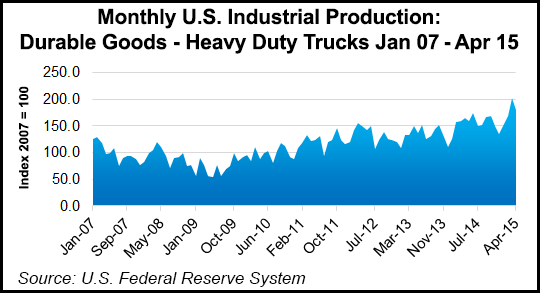LNG in Heavy-Duty Vehicles Expected to Grow Slowly Over Decade
The use of liquefied natural gas (LNG) as a transportation fuel in the heavy-duty vehicle market will grow slowly over the next 10 years, unless there are aggressive marketing efforts, according to the latest Oil & Gas Market Notes published by Navigant Consulting.

LNG’s principal attraction in the heavy-duty sector is that it can be stored with 2.5 times more energy in the same volume compared to compressed natural gas (CNG), the most pervasive form of fueling natural gas vehicles (NGV). With the shale gas boom throughout North America, interest in LNG use in the heavy-duty transport sector has grown, albeit modestly, according to Navigant Director Nick Allen, who authored the report.
There are common opportunities and challenges for all of the low-carbon fuel alternatives seeking to unseat a part of the well entrenched gasoline and diesel fuel markets, Allen said.
“Limited growth” is predicted for LNG heavy-duty vehicle sales during the next 10 years with global annual sales increasing from 20,000 to 55,000 by 2025. “This equates to a marginal increase in their penetration of all medium and heavy-duty vehicles from 8% to 9%,” Allen said.
Last month, a stakeholder panel at the IHS CERAWeek conference in Houston concluded that growth in the natural gas transportation sector was most likely to come through incentives in the heavy-duty vehicle market (see Daily GPI, April 29).
Allen outlined a change of paradigm and acceleration of new markets for LNG as a heavy-duty transport fuel. That framework calls for learning from other introductions of fuels into the transportation sector, along with a set of seven rules he calls the “7Cs” that include market conditions, collaboration, understanding challenges and developing a commercial case.
“Key stakeholders need to be completely aligned, fully agreed and 100% committed to the change,” said Allen, adding that regulators play a key role in defining specific fuel regulations. He cites the problems Germany had in 2011 introducing 10% ethanol into its gasoline supplies and getting consumer acceptance because the regulators did not seek alignment before the launch of the gasoline additive (E-10).
Before pushing ahead with LNG in the heavy-duty vehicle market, the fundamentals of that market must indicate “the conditions are right” to create an LNG-in-transport market, Allen said. “Given the complex nature of the value chain surrounding LNG in transport, rarely can a single player consider the opportunity in isolation.”
While not concluding categorically that LNG can successfully win over the heavy-duty market, Allen said successfully making inroads is no more complex than it is for rival alternative fuels, such as hydrogen fuel cells and electric vehicles. They all involve “complex value networks with multiple players and significant capital investment required.
“What is clear, though, is that we will continue to see innovative players, facilitated by catalysers working together to create new markets for low-carbon transport solutions.”
© 2024 Natural Gas Intelligence. All rights reserved.
ISSN © 1532-1231 | ISSN © 2577-9877 |
